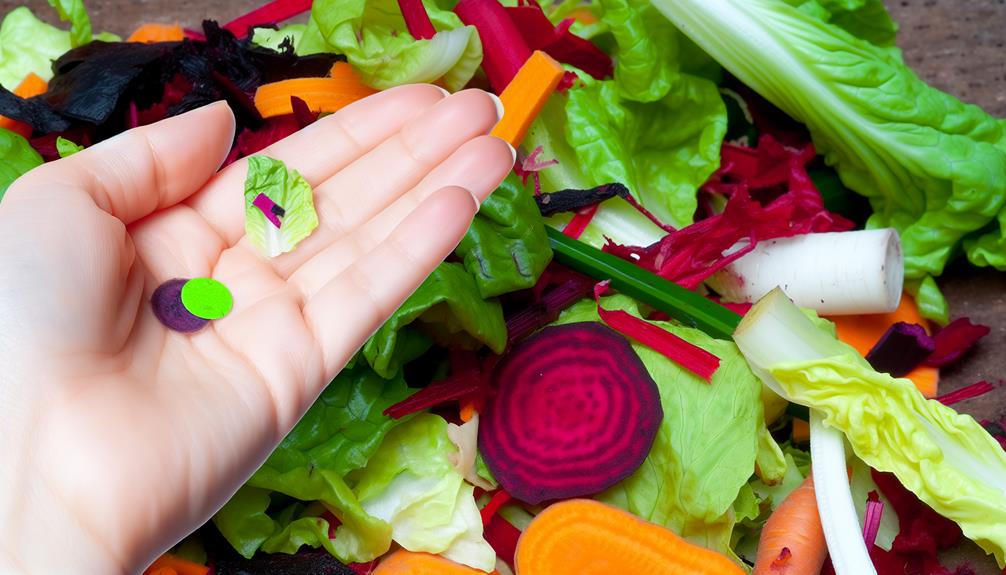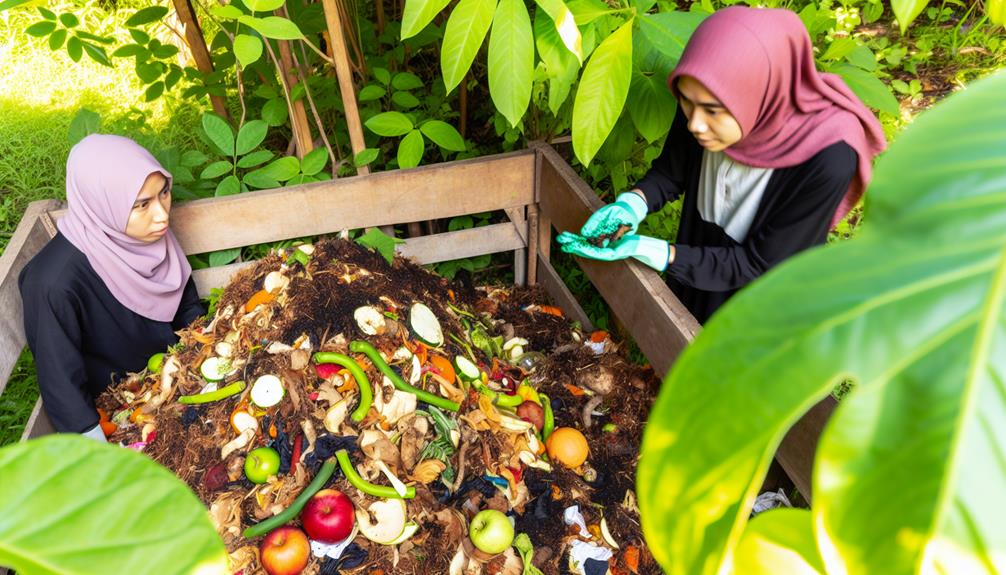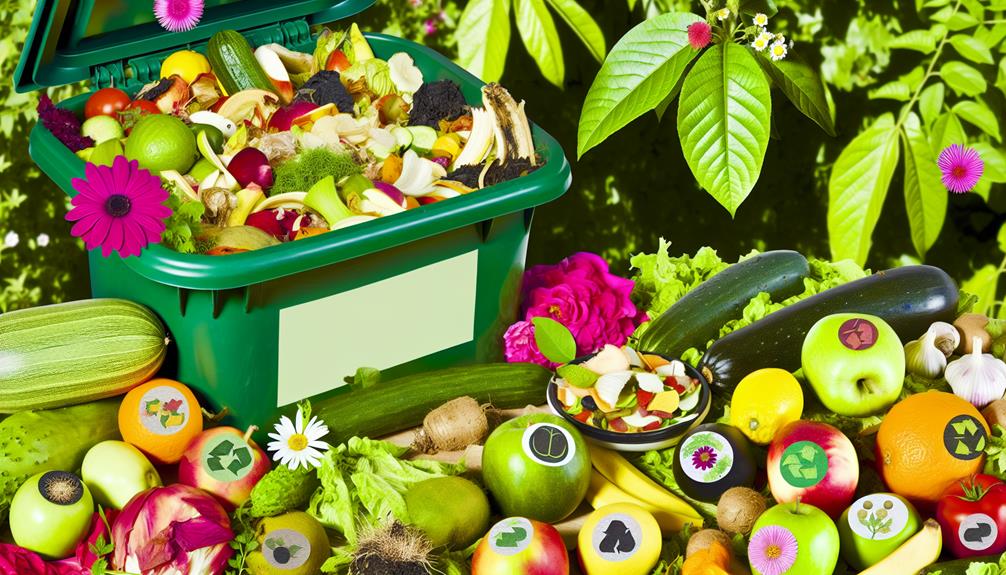

You can’t compost produce stickers because they’re made from non-biodegradable materials like plastic or vinyl. These stickers contain adhesives and inks that don’t break down and can contaminate your compost, hindering decomposition and reducing its quality. To maintain your compost’s purity, always peel off the stickers before composting fruits and vegetables, and dispose of them in the trash.
For a more sustainable option, look for produce with laser-etched labels or biodegradable stickers made from cellulose. By doing this, you support eco-friendly practices, ensuring a healthier decomposition process. For more sustainable tips and alternatives, keep exploring.
Produce stickers are small labels placed on fruits and vegetables to provide information like price look-up codes and country of origin. When you pick up an apple or a bunch of bananas, you’ll often see these stickers. They’re not just for looks—they serve an essential role in the grocery industry.
These stickers include various identification codes, like the PLU (Price Look-Up) codes, which help cashiers quickly identify the item and its price. This system guarantees you’re charged correctly and speeds up the checkout process.
Besides PLU codes, these stickers often display the country of origin, helping you know where your produce comes from.
You might wonder how these stickers stick so well to the produce. That’s where label adhesives come into play. These specialized adhesives are designed to adhere to the skin of fruits and vegetables without damaging them. They need to be strong enough to stay attached during transport and handling but also safe for contact with food.
Understanding the purpose and components of produce stickers can help you appreciate their role in our food system. The next time you see one, you’ll know exactly why it’s there and what it’s telling you.
Also Read: Can You Compost Rotten Bananas?
You’ll find that the materials used in produce stickers are essential for making sure they adhere well and remain safe for food contact. These stickers usually consist of three primary components: the adhesive composition, the face stock, and the ink used for sticker printing. Each of these materials plays a vital role in the sticker’s functionality.
The adhesive composition ensures that the sticker stays put on the produce. It’s crafted to be food-safe and non-toxic, making it suitable for direct contact with fruits and vegetables. The face stock, which forms the base of the sticker, is typically made from paper or plastic. This layer is what you see and touch when handling produce.
Sticker printing involves using various inks that won’t leach harmful substances onto the food. These inks are specially formulated to be durable and resistant to moisture.
Here’s a quick breakdown:
| Component | Material | Purpose |
|---|---|---|
| Adhesive Composition | Food-safe adhesive | Ensures sticker adhesion |
| Face Stock | Paper or plastic | Provides the sticker’s base |
| Printing Ink | Non-toxic ink | Displays information without harm |
Understanding these materials helps you make informed decisions about the produce you buy and how to handle the stickers.
Also Read: Can You Compost Ice Cream?
When you toss produce stickers into your compost bin, they can hinder the decomposition process due to their non-biodegradable materials. These stickers are often made from plastic or vinyl, which don’t break down naturally in a compost environment. This means they remain intact and can contaminate your otherwise nutrient-rich compost.

The environmental effects are significant. Plastic fragments from these stickers can leach harmful chemicals into the soil, affecting plant growth and potentially entering the food chain. Moreover, the presence of non-compostable items can reduce the quality of your compost, making it less effective for gardening and landscaping.
Consumer awareness is important in addressing this issue. By understanding the impact of tossing produce stickers into compost, you can make more informed decisions. Always remove stickers from fruits and vegetables before composting them. This small step helps maintain the integrity of your compost and supports a healthier environment.
As part of a community that cares about sustainability, sharing this knowledge can encourage others to be mindful of their composting practices. By working together, we can minimize the negative impact on our compost and contribute to a greener planet.
Also Read: Can You Compost Mail?
To properly dispose of produce stickers, simply peel them off and throw them in the trash before composting your fruits and vegetables. This small step can make a big difference in maintaining the quality of your compost. Produce stickers and their adhesives aren’t biodegradable and can contaminate your organic waste, making it less effective.
When you remove these stickers, you’re helping to keep your compost clean and pure. It’s a straightforward process: just use your fingers or a small knife to lift the edge of the sticker and peel it away. Dispose of the sticker in your regular trash bin.
This habit ensures that only organic waste goes into your compost pile, promoting a healthier decomposition process.
Also Read: Can You Compost Rust?
Instead of relying on traditional produce stickers, consider using sustainable alternatives that are both eco-friendly and compostable. One viable option is the use of laser-etched labels. These labels involve etching information directly onto the skin of the fruit or vegetable, eliminating the need for stickers altogether. This method has been gaining traction due to its minimal environmental impact.

Another alternative is biodegradable stickers made from materials like cellulose, derived from plants. These stickers break down more easily in composting environments, aligning with eco friendly packaging practices. Biodegradation studies have shown that such materials decompose much faster than conventional plastic stickers, reducing waste in landfills.
You can also explore the option of using natural adhesives for labels. These adhesives are made from organic materials and are designed to break down without harming the environment. By choosing produce packaged with these sustainable alternatives, you’re supporting a more eco-conscious lifestyle.
Lastly, encourage your local grocery stores to adopt these practices. When more people demand eco-friendly solutions, businesses are more likely to make the switch. Together, we can create a more sustainable world, one sticker at a time.
You might wonder why stores use produce stickers. They help with supply chain efficiency and inventory management. When you see those little stickers, you’re seeing a tool that keeps your favorite stores stocked and organized.
You might wonder if produce stickers are edible. They’re not safe to eat due to their materials and adhesive ingredients. For a healthier choice, always remove the stickers before enjoying your fruits and veggies.
When you leave produce stickers in the soil, they can cause soil contamination and negatively affect its microbial impact. By removing them, you help maintain healthy soil, fostering a sense of community and environmental stewardship.
You can’t recycle produce stickers due to their material and adhesive, creating recycling challenges. Their environmental impact is significant, so always remove them before composting to help protect our planet and foster a sustainable community.
You might wonder if produce stickers pose health risks. Their chemical composition and sticker adhesives are generally safe, but it’s best to remove them before eating. Doing so helps you feel more connected to your food choices.
To compost effectively, always remove produce stickers first. These stickers often contain non-compostable materials like plastics and adhesives. Dispose of them in the trash to avoid contaminating your compost.
Whenever possible, choose produce with sustainable alternatives such as biodegradable stickers or no stickers at all. By doing so, you’ll keep your compost clean and eco-friendly.
Remember, small actions like these contribute significantly to reducing waste and promoting sustainability.
